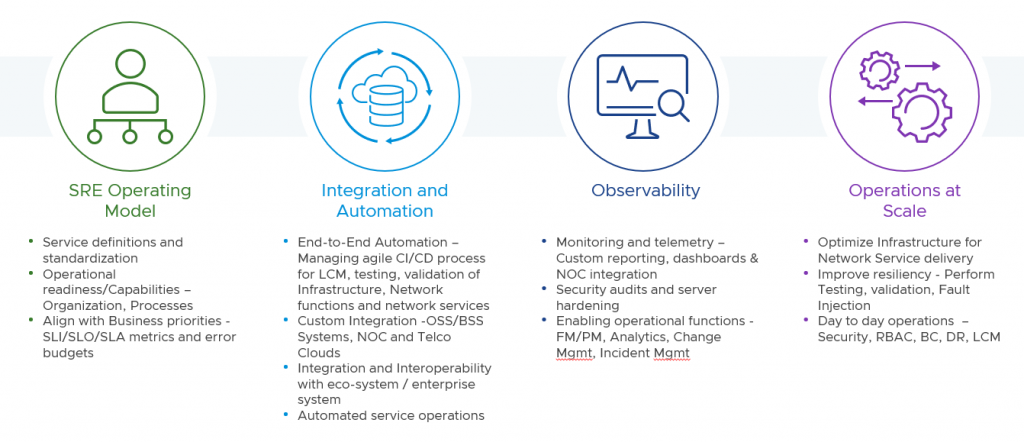The telco market is undergoing a massive transformation. Communication Service Providers (CSPs) are making a big push to move to 5G networks based on virtualized cloud-native architectures. As CSPs make this shift, it is tempting to focus on Day 0 (planning and design) and Day 1 (configuration and deployment), but ignoring Day 2 (daily and ongoing operations) is a mistake. For telcos looking to leverage the cloud and new open-standards architectures, planning for Day 2 operations from the beginning is paramount.
Day 2 Objectives
Through our work with large telcos around the world, VMware Professional Services has found that the telcos have several Day 2 operations objectives in common. The primary goal for most CSPs is to accelerate network service, delivery, and innovation while controlling operational costs. To achieve this goal, their five primary objectives typically are:
- Rapidly roll out new network services and capabilities
- Deliver carrier-grade service reliability
- Automate everything
- Integrate with best-of-class ecosystems
- Optimize and operate at scale
The reality for most of the CSPs we work with is that they are hosting virtualized network functions on highly complex, distributed, heterogeneous telco cloud deployments. These networks are hard to automate, scale, and manage. This combination of high complexity and low automation drives high operations cost, efficiency issues, configuration drift, security vulnerabilities, and reliability risks. To realize the full potential of the service-based 5G architecture, automation and standardization are key.
To manage these complex network service deployments and to improve efficiency, VMware works with our customers to set up three key Day 2 priorities.
- Align operations with business priorities – This sounds basic, but this step is often overlooked or ignored because of siloed teams and a lack of communication. The goal is to establish key performance indicators (KPIs) that align with a customer’s larger business objectives.
- Establish end-to-end automation – With the large number of network elements that are required for 5G networks, automation is key for agile service delivery. Automation is needed for testing, validation, on-boarding, and delivery of network services.
- Operate reliability at scale – The keyword for this priority is scale. It is often overlooked in Day 0 and Day 1 phases. The network must operate reliably as traffic patterns change and new devices are added to the network. Find out more about how to confidently roll out software-based network functions with these testing tips.
The Role of Site Reliability Engineering
To help achieve these priorities and to have successful Day 2 operations, VMware suggests that our customers use Site Reliability Engineering or SRE. It is a dedicated function within an organization that incorporates aspects of software engineering and operations management. SRE involves defining common standards and practices, automating network operations, monitoring and improving operations, and implementing CI/CD processes and automation for service delivery. A major goal of SRE is to keep systems up –to date with patches and upgrades while reducing duplication of efforts as much as possible. SRE teams can also help automate manual tasks, such as provisioning access and infrastructure, setting up accounts, and building a catalog of services for your users or customers.
VMware Professional Services provides SRE services to many of our telco customers. VMware Professional Services has an agile approach to SRE, where we perform a product backlog of tasks in sprints and leverage existing VMware-developed assets tailored to each organization’s needs. This approach allows us to improve efficiency, reliability, and availability. As SRE services are integrated into an organization, our experts focus on integration and automation, observability, service assurance, and ensuring operations at scale. As part of SRE onboarding, a new SRE operating model is created to make sure SRE integrates seamlessly with your processes and engages with all levels of your IT team.
To help get understand the activities an SRE can perform, let’s look at some sample tasks for each of these SRE areas.

The SRE from VMware performs a range of activities from simple break-fix for network outages to proactive monitoring. This team of VMware product experts can continually provide VMware platform maintenance, configuration management, and release management of VMware platforms as well as knowledge transfers.
Optimize Your Telco Operations with SRE
Our customers find that SRE can bring immediate value for Day 2 operations. Our team of experts can:
- increase operational efficiency
- minimize toil
- reduce human error
- decrease development cycle time
- establish visibility into performance and service health
In addition to the stand-alone value SRE brings, SRE works conjunction with other VMware professionals such as our Success Executives, Technical Account Managers (TAMs), and our Support Services Managers. By leveraging SRE along with other Professional Services, you can quickly and efficiently optimize your telco operations. VMware Professional services allow you to leverage experts with the right knowledge and skills, take advantage of best practices and proven methodologies, and minimize disruptions to resources and operations.
Cloud-Native Transformation with VMware Professional Services SRE
Making the move to a cloud-native architecture can have tremendous benefits for CSPs. However, proper steps must be taken for each phase of the process – Day 0, Day 1, and Day 2. Day 2 operations are often the most important aspect of this transition, but often the most overlooked. Visit VMware’s website to learn how VMware products can be used to build a cloud-native Telco cloud and how our professional services can help integrate cloud-native operations with your day-to-day business.
To learn more, be sure to join us at MWC – hall 3, Stand 3M11.
Discover more from VMware Telco Cloud Blog
Subscribe to get the latest posts sent to your email.









